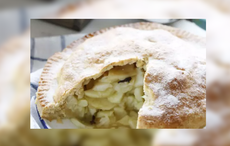On July 14th the French celebrate Bastille Day, marking the end of Monarchy and the beginning of the French Revolution. The storming of the Bastille launched France's establishment as a nation of liberty.
Okay. So perhaps we are still a bit miffed. The French are not the allies they once were (to put it mildly). But please, Mon Amis, let us not be political here.
We are here to talk about food, glorious food, and surely you will admit that it is somewhat difficult for a serious cook to totally ignore the culinary contributions of la belle cuisine of France over the centuries.
I worked in France for a couple of years when I began my culinary career and one of my fondest memories {the only fond memory!} was in the French Alps. We would Ski to our nearest neighbors and have an aperitif before dinner, now these were simple farming folk nothing like the Parisians and they would offer us a Kir, which is white wine with Cassis added to it and usually a little snack like French bread, some cheese or saucisson (French large, dry-filled sausage with peppercorns studded through it}
One day our neighbor had made a potato gratin with the milk from his goats and sitting by his homemade fire drinking the wine and slobbering down this peasant potato dish was better than any 5 star restaurants on the Champs-Élysées.
THE "UPPER CRUST" POTATO GRATIN
(Le Gratin des Gratins)
I am sure that if you polled a hundred Frenchmen, each one would have a strong opinion on the ‘best’ potato gratin. Well, for me the ‘best’ is the one I just told you about. This recipe brings up the ever-present question of ‘to wash or not to wash.’ {I am talking about the potatoes here not the infamous French lack of hygiene!} There are those who believe that all potatoes should be rinsed of starch, which on its own does not have a pleasing flavor. Others enjoy the earthiness the starch imparts. Since you’re the cook, you can have it your way. Or try the recipe both ways and see which is closer to your own taste.
The actual name for this potato gratin called "gratin dauphinois", very famous in the Grenoble region where it comes from (an hour east of Lyon, at the foot of the Alps). Purists would argue that this isn't a "true" gratin dauphinois because I am using cheese, which would make this dish a "gratin Savoyard" (from Savoie region, just north of Dauphiné) but whatever. It tastes great!
INGREDIENTS
Equipment: One oval baking dish (about 9 x 13 inches)
Yield: 6 to 8 servings
3 pounds baking potatoes, such as Idaho Russets
1 quart whole milk {or if you can get goats milk, use it}
Bouquet garni: {several parsley stems, celery leaves, and sprigs of thyme, wrapped in the green part of a leek and securely fastened with cotton twine}
Freshly grated nutmeg to taste
Sea salt to taste
2 tablespoons unsalted butter
1 cup heavy cream
2 cups freshly grated imported Gruyère cheese
Freshly ground white pepper to taste
1 plump fresh garlic clove, halved lengthwise
METHOD
Preheat the oven to 375 degrees F.
Peel and thinly slice the potatoes. If desired, rinse the potatoes to rid them of starch. Dry thoroughly in a thick towel.
In a large saucepan, combine the potatoes, milk, bouquet garni, nutmeg, salt, and 1 tablespoon of the butter, and bring to boil over moderately high heat. Stir occasionally to prevent the potatoes from sticking to the bottom of the pan. Reduce the heat to moderate and cook, stirring occasionally, until the potatoes are tender but not falling apart, about 10 minutes.
Prepare the topping:
In a medium-size bowl, combine ½ cup of the cream and 1 cup of the cheese, and stir to blend. Set aside.
Rub the bottom of the baking dish with the garlic and the remaining 1 tablespoon butter. With a slotted spoon, transfer half the potatoes to the baking dish. Sprinkle with additional nutmeg, pepper, the remaining ½ cup cream, and the remaining 1 cup cheese. Cover with the remaining potatoes and sprinkle again with nutmeg and pepper. Cover with the reserved topping. Discard the milk and the bouquet garni.
Place the baking dish in the center of the oven and bake until the potatoes are crisp and golden on top, about 1 hour.
Serve immediately.
A Touch of Garlic
To some cooks, the idea of rubbing a baking dish with a halved clove of garlic, then discarding the garlic, seems like a waste of time. The trick is to rub the bottom of the dish vigorously and thoroughly, so that the clove of garlic all but falls apart and seems to disappear, totally impregnating the baking dish with its essence. As the gratin bakes, the garlic gently flavors the potatoes and milk, adding that essential touch of extra seasoning.
AND FINALLY…
Q: How do you get a French waiter's attention?
A: Start ordering in German.
Bon appétit!




Comments